Physical Address
304 North Cardinal St.
Dorchester Center, MA 02124
Large artery atherothrombosis, cardiac embolism, and small-artery disease are important stroke mechanisms of posterior cerebral artery territory infarction.
The clinical features of thalamic infarction vary according to vascular topography: the inferolateral, tuberothalamic, paramedian, and posterior choroidal arteries.
Inferolateral territory infarction is the most common type of thalamic infarction, and the main clinical features are hemisensory deficits.
The main clinical features of tuberothalamic and paramedian territory infarctions are neuropsychiatric disturbances including somnolence, memory deficits, etc.
The most important clinical feature of cortical posterior cerebral artery infarction is visual field defect, especially homonymous hemianopia.
Memory deficits and various types of cognitive dysfunction associated with visual disturbances are encountered in patients with cortical posterior cerebral artery infarction.
The prognosis of pure posterior cerebral artery territory infarction is relatively good, but sensory dysfunction and visual field defect may remain as troublesome sequelae.
The posterior cerebral artery (PCA) originates at the terminal bifurcation of the basilar artery (BA). Both PCAs arise from the BA in 70% of cases, the PCA arises from the posterior communicating arteries in 20%, and the origin is mixed in 10% ( Figs. 25.1 and 25.2 ).
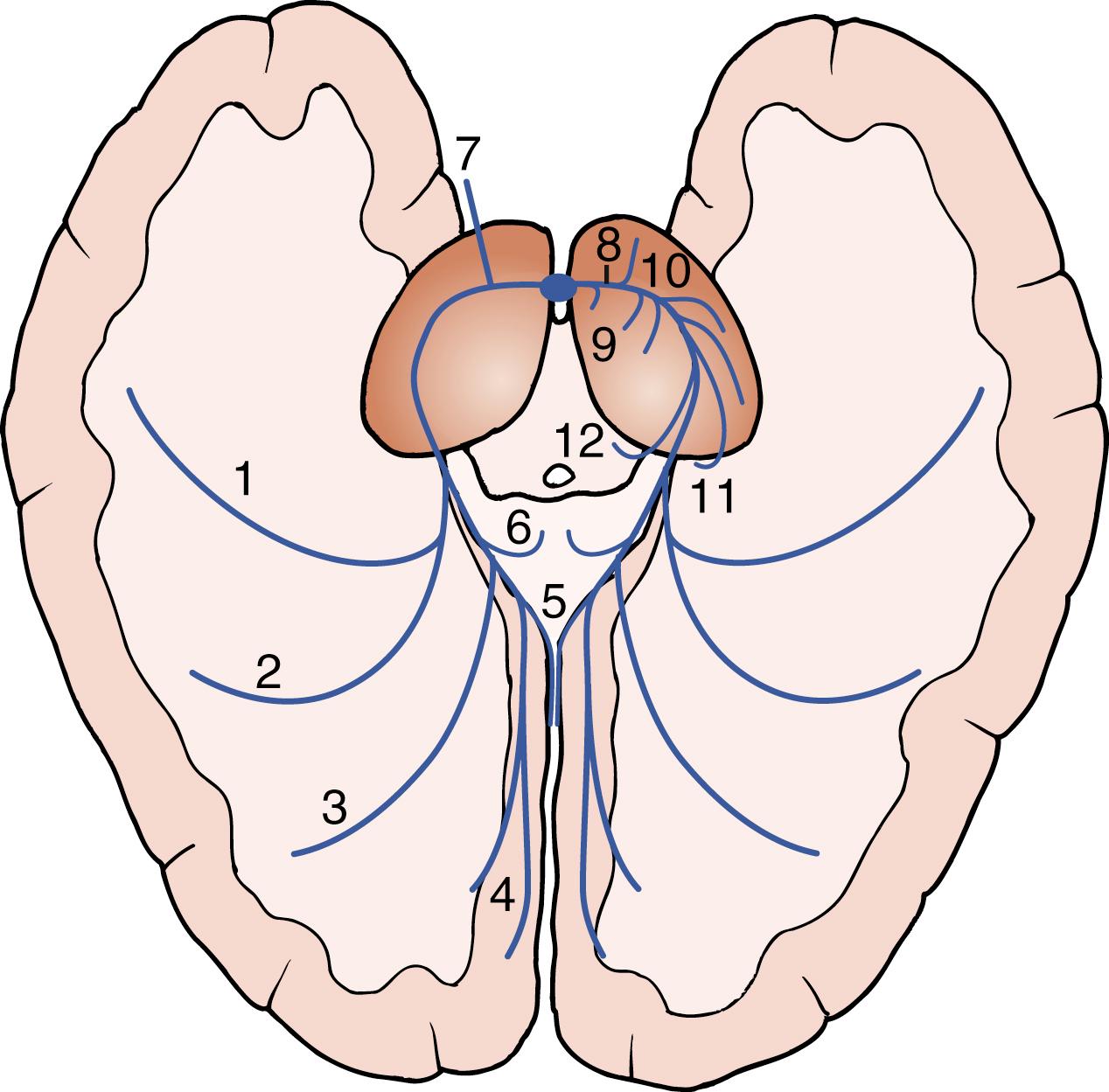
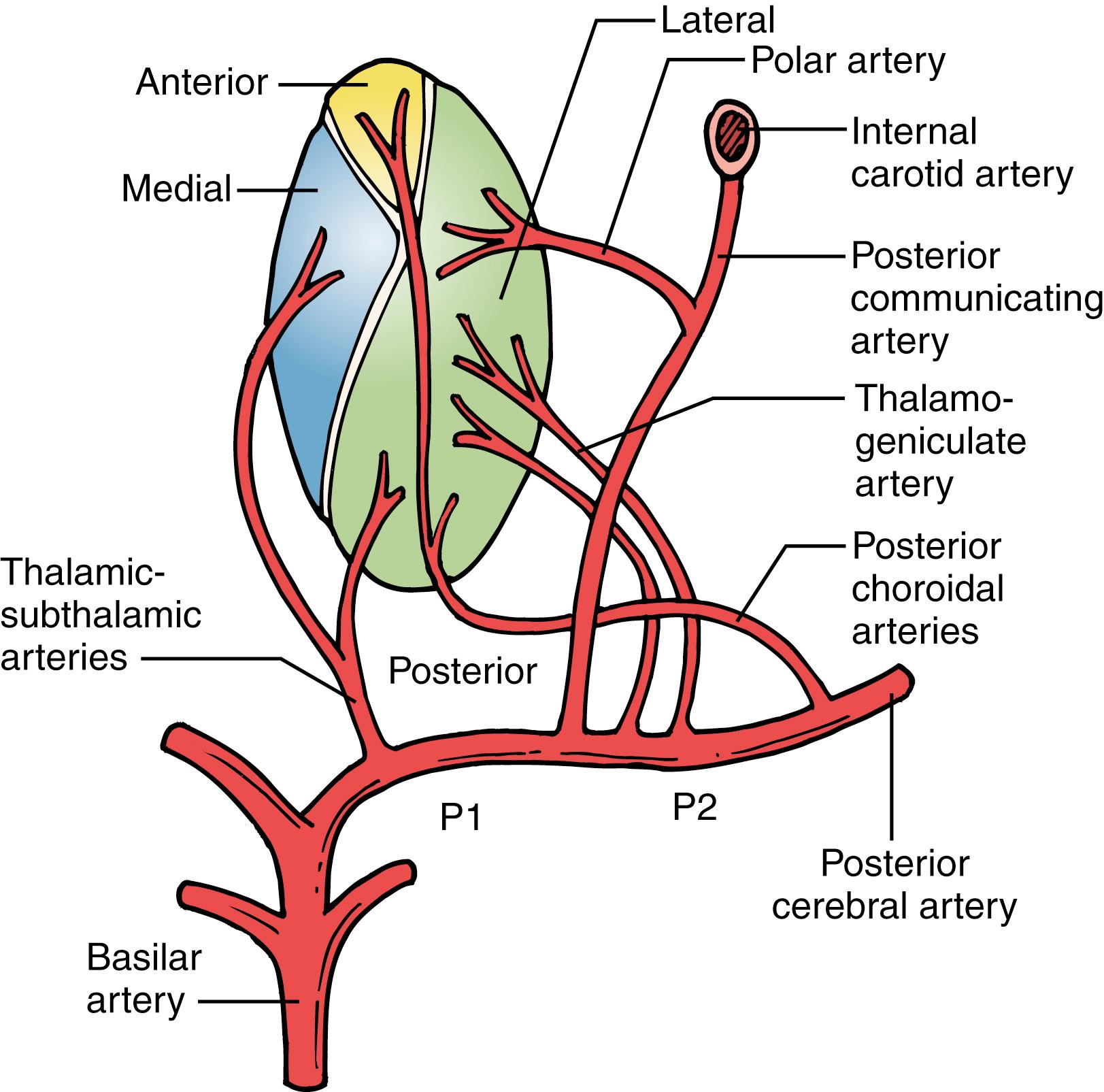
In the proximal portion of the PCA, the penetrating branches arise and supply the deep structures such as the midbrain and thalamus. The initial portion of the PCA—the segment between the top of the BA and the origin of the posterior communicating artery—is referred to as the P1 segment. P2 refers to the segment after the communicating artery. In patients with fetal PCA, the P1 segment is hypoplastic or absent.
The main branches of the P1 segment include the paramedian arteries that supply the medial portion of the rostral midbrain (mesencephalic arteries) and the thalamic arteries (thalamic-subthalamic artery). The perforating arteries are 200 and 400 μm in diameter, respectively. The anterior and anterolateral portions of the thalamus are usually supplied by the tuberothalamic arteries (polar or premammillary), which generally arise from the posterior communicating arteries; however, in some patients, the tuberothalamic arteries are absent, and these areas are supplied by the paramedian arteries.
In the segment distal to the posterior communicating artery (P2 portion), there arise peduncular perforating arteries that supply the lateral midbrain, and thalamogeniculate (inferolateral) arteries supplying the ventrolateral (VL) portion of the thalamus. These arteries measure between 320 and 800 μm in diameter and contain between 8 and 10 branches. The thalamogeniculate, posterior thalamic, and pulvinarian branches curve upward into the posterior portions of the thalamus to supply the posterolateral nuclei and pulvinar. There are also several medial and lateral branches in the posterior choroidal artery. The choroidal arteries supply the choroid plexus of the lateral ventricle, pulvinar, the posterior part of dorsolateral nucleus, lateral geniculate body (LGB), hippocampus, and mesial temporal lobe. ,
P3 and P4 segments refer to the distal, superficial segments of PCA with cortical branches. Distal to the peduncle, the PCA initially courses downward and backward into the ambient cistern immediately below the tentorium cerebelli, just above and slightly lateral to the superior cerebellar artery, then curves upward and medially to the quadrigeminal cistern. After crossing above the medial edge of the tentorium, the PCA reaches the medial surface of the occipital lobe near the anterosuperior border of the lingual gyrus just below the splenium of the corpus callosum. As it reaches the surface, it divides into two major divisions: one angling sharply forward and the other continuing posteriorly to become the calcarine artery.
Anterior division gives rise to the two inferior temporal arteries: the anterior and posterior. These branches supply the ventral surface of the temporal and occipital lobes. They anastomose with the middle cerebral artery (MCA) via a borderzone network that runs roughly along the margin of the hemisphere, where the ventral surfaces become convex. The anterior, inferior, and posterior temporal arteries usually originate from a single trunk; less often, these and the occipitotemporal branch arise from a common trunk.
The posterior division yields three major branches in sequence: the occipitotemporal, calcarine, and occipitoparietal arteries. The occipitotemporal branch supplies the undersurface of the occipital lobe, including the posterior portion of the fusiform and lingual gyri.
The calcarine artery, which may be single or double, supplies the calcarine cortex and medial surface of the occipital lobe as far distal as the occipital pole, anastomosing with terminal branches of the MCA. The branches of the occipitoparietal artery supply the splenium and portions of the precuneus and cuneus, and along a borderzone network, the terminal vessels anastomose with branches of the anterior cerebral artery (ACA).
PCA territory infarction is caused by large-artery disease, small-artery disease, cardiogenic embolism, and other uncommon etiologies ( Table 25.1 ). The prevalence of stroke mechanism differs according to the characteristics of studies; some were based on autopsy findings while others used imaging data. Imaging quality (e.g., computed tomography [CT] vs. magnetic resonance imaging [MRI], sonography vs. angiogram) and the extent of vascular or cardiac workup would affect the final results. In addition, inclusion criteria were often heterogeneous. Some defined PCA infarction only when the superficial PCA territory (i.e., the occipital area) was involved, , , , while others also considered infarcts restricted to deep structures. , Some papers even considered the patients with superficial PCA territory involvement only. Moreover, some studies considered infarcts that occur only in the PCA territory, , , whereas others included infarcts that occur in extra-PCA territories. , Ethnicity may further complicate this issue because Asians develop intracranial atherosclerosis and small-artery disease more often, and cardiogenic embolism less often, than Caucasians. , These heterogenic aspects should be considered when evaluating the literature.
| Pessin et al. | Moriyasu et al. | Steinke et al. | Yamamoto et al. | Cals et al. | Kumral et al. | Lee et al. | Arboix et al. | Ntaios et al. | |
|---|---|---|---|---|---|---|---|---|---|
| Published year | 1987 | 1995 | 1997 | 1999 | 2002 | 2004 | 2009 | 2011 | 2011 |
| Country | USA | Japan | Germany | USA | Switzerland | Turkey | Korea | Spain | Greece |
| Number of patients | 35 | 85 (72 a ) | 74 | 79 | 117 | 137 | 126 | 232 | 122 |
| Diagnostic imaging | CT | CT/MRI | CT/MRI | CT/MRI | CT/MRI | CT/MRI | DWI | CT/MRI | CT/MRI |
| Vascular imaging | NM | ||||||||
| MR angiography | None | None | 31 (42%) | 40 (51%) | 15 (13%) | 137 (100%) | 126 (100%) | 33% | |
| Conventional angiography | 23 (66%) | 72 (85%) | 22 (30%) | 28 (35%) | 36 (31%) | NM | NM | 10% | |
| Included topography | Cortical | NM | Cortical | Cortical | Cortical only | Cortical | Cortical | Cortical | Cortical |
| Cortical+ deep | Cortical + deep | Cortical + deep | Cortical + deep | Cortical + deep, | Cortical + deep, | Cortical + deep | |||
| deep | deep | ||||||||
| Stroke mechanism | |||||||||
| Large-artery disease | 6 (17%) | 11 (15%) | 22 (31%) | 32 (41%) | 15 (13%) | 69 (50%) | 51 (41%) | 68 (29%) | 31 (25%) |
| PCA atherothrombosis | None | 2 (3%) | 6 (8%) | 7 (9%) | 2 (2%) | 36 (26) | 38 (19%) | NM | 15 (12%) |
| VA, BA atherothrombosis | 6 (17%) | 9 (11%) | 16 (22%) | 25 (32%) | 13 (11%) | 33 (24%) | 10 (5%) | NM | 16 (13%) |
| PCA+VB atherothrombosis | NM | NM | NM | NM | NM | NM | 36 (18%) | NM | NM |
| Cardiac embolism | 10 (29%) | 12 (17%) | 23 (31%) | 32 (41%) | 51 (44%) | 29 (21%) | 20 (16%) | 50 (22%) | 58 (48%) |
| Small artery disease | NM | NM | NM | NM | NM | NM | 41 (33%) | 80 (35%) | NM |
| Cause undetermined | 11 (31%) | NM | 18 (24%) | NM | 38 (32%) | 22 (16%) | 14 (11%) | 20 (9%) | 25 (20%) |
| Uncommon causes | 8 (22%) | 5 (6%) | 11 (15%) | 7 (9%) | 8 (7%) | 16 (12%) | NM | 14 (6%) | 8 (7%) |
a Analysis of mechanism was performed only in 72 patients who underwent angiography.
The main pathology of large-artery disease consists of thromboses that are superimposed on atherosclerosis. In posterior circulation, atherosclerosis often occurs in the proximal vertebral artery (VA), distal intracranial VA, the lower-middle portion of the BA, and proximal PCA. , Detailed stroke mechanisms include artery-to-artery embolism, branch occlusion, in situ thrombotic occlusion, hemodynamic impairment, and their various combinations.
Large-artery atherothrombosis is an important cause of PCA territory infarction. In patients with significant proximal artery (VA, BA, subclavian artery, and aorta) atherosclerosis, ulcerative plaques may be detached to generate emboli that occlude the PCA and/or its branches ( Fig. 25.3 ). , Artery-to-artery embolism accounts for 11%–32% of PCA territory infarction (see Table 25.1 ). VA disease (either extracranial or intracranial) is the most common source of embolism, followed by BA atherosclerosis. It seems that posterior fossa hypoperfusion due to bilateral VA disease and contralateral VA hypoplasia predisposes the formation of emboli. , Although uncommon, internal carotid artery (ICA) disease can produce embolic PCA infarction in patients with fetal-type PCA. , ,

The role of intrinsic PCA atherosclerosis as a cause of PCA territory infarction remains uncertain, even though the proximal PCA is a predilection site of atherosclerosis. Previous studies report a low (<10%) prevalence of intrinsic PCA disease in patients with PCA infarction (see Table 25.1 ). , However, this may in part be due to insufficient vascular examination. Recent studies in Turkey and Korea, where MR angiogram (MRA) was performed on all the cases, identified PCA atherosclerosis as a cause of PCA territory infarction in 20%–25% of cases, suggesting that PCA atherosclerosis is also an important source of embolism in patients with PCA territory infarction. Studies using doppler-monitoring and diffusion-weighted MRI (DWI) described artery-to-artery embolism (from the proximal PCA to distal branches) as an important mechanism of occipital infarction in patients with PCA disease ( Fig. 25.4C ). As expected, unlike PCA infarcts associated with more proximal-artery disease, embolic infarction that originates from PCA atherosclerosis is always confined to the PCA territory.
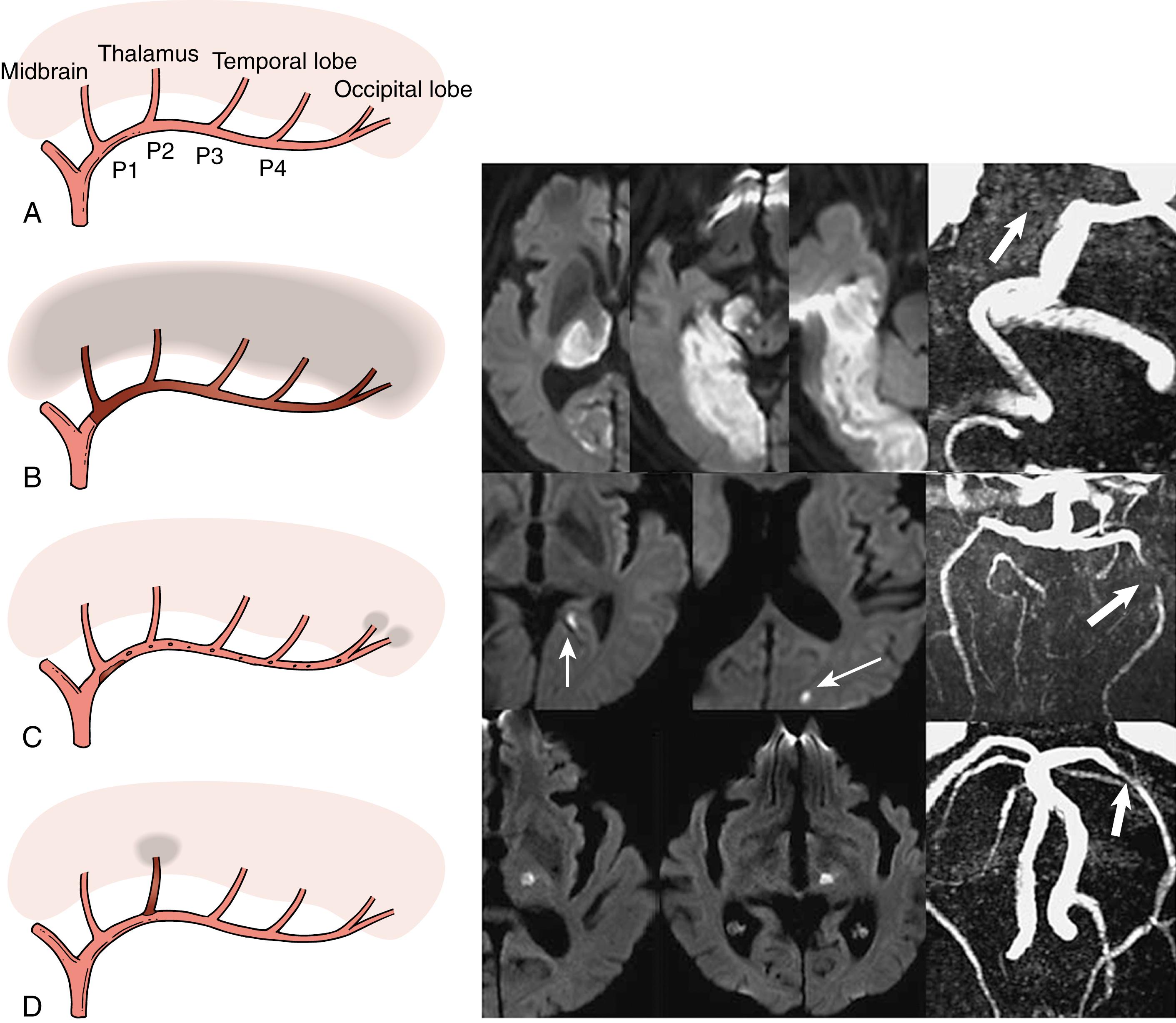
Atherosclerotic plaques in an intracranial artery can occlude the orifice of one or several perforators, causing infarction that is limited to the perforator territory (see Fig. 25.4D ). This so-called “atheromatous branch occlusion” , seems to be a more important stroke mechanism in Asians, who demonstrate prevalent intracranial atherosclerosis. , Branch occlusion is more often observed in posterior than anterior circulation stroke, and is an important stroke mechanism of deep PCA territory (midbrain and thalamus) infarction associated with atherosclerosis in the P1 and P2 portions of the PCA. , , A recent Korean study showed that branch occlusion was the most important stroke mechanism in patients with intrinsic PCA atherosclerosis and that the thalamus was the most commonly involved region. Asian studies have reported that branch occlusion in association with PCA atherosclerosis accounts for 7%–22% of lateral thalamic infarction. , Generally, arterial stenosis associated with branch occlusion is milder in degree than that causing artery-to-artery embolism or in situ thrombotic occlusion. However, small thalamic infarcts may occur in patients with complete PCA occlusion who probably have well developed collateral circulation ( Fig. 25.5 ).
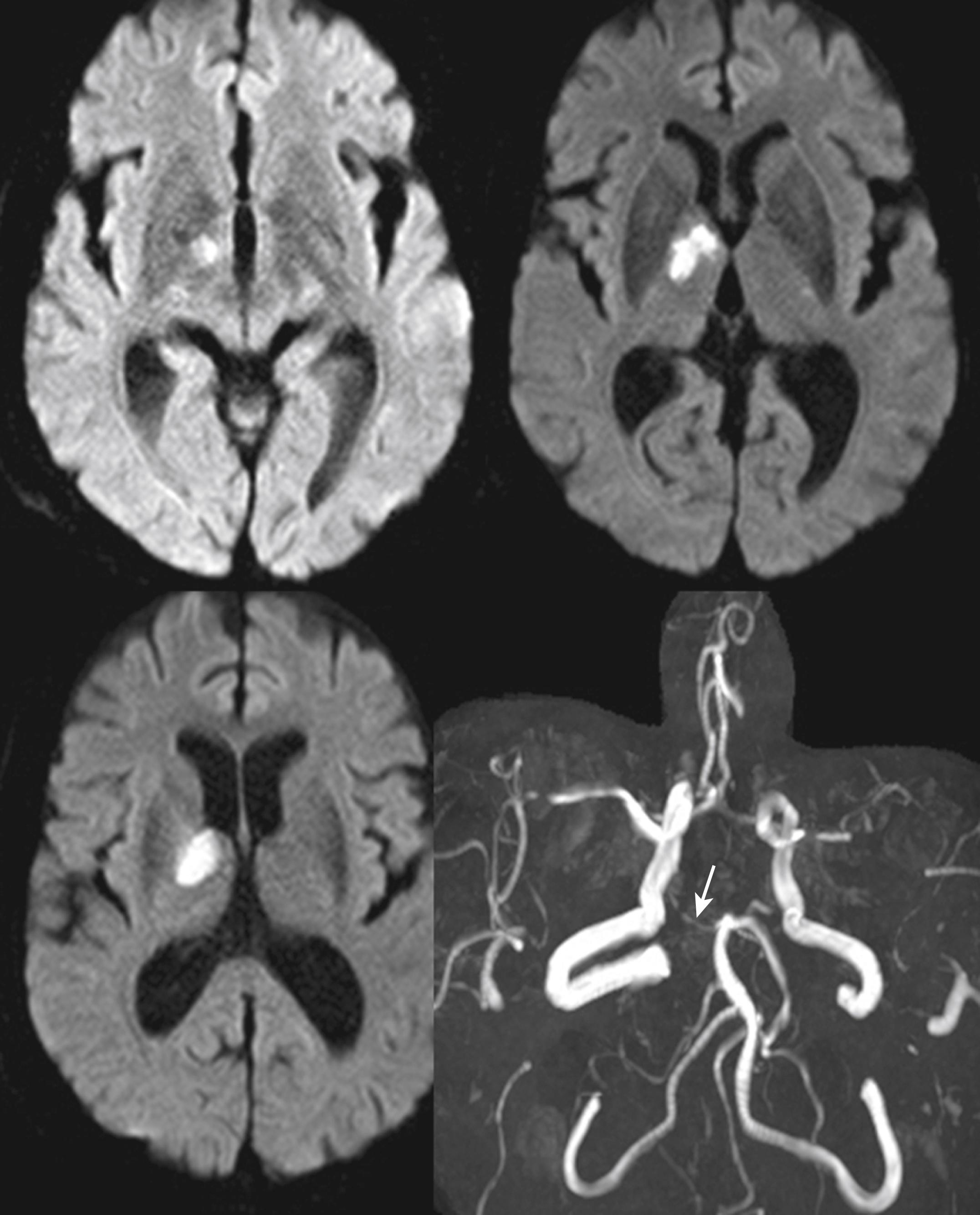
Lateral thalamic infarcts associated with PCA stenosis (branch occlusion) tend to enlarge over time, and are associated with complex symptoms (ataxia and/or hemiparesis in addition to sensory disturbances) and worse clinical outcomes than infarcts associated with small-artery disease ( Fig. 25.6 ). Branch occlusion may also play a role in the pathogenesis of thalamic infarction in other perforator territories ( Figs. 25.7 and 25.8 ). Although the exact prevalence has not been identified a DWI and MRA study reported that among 37 patients with pure midbrain infarction, branch occlusion in association with either BA or PCA atherosclerosis was the presumed stroke mechanism in 17 patients.

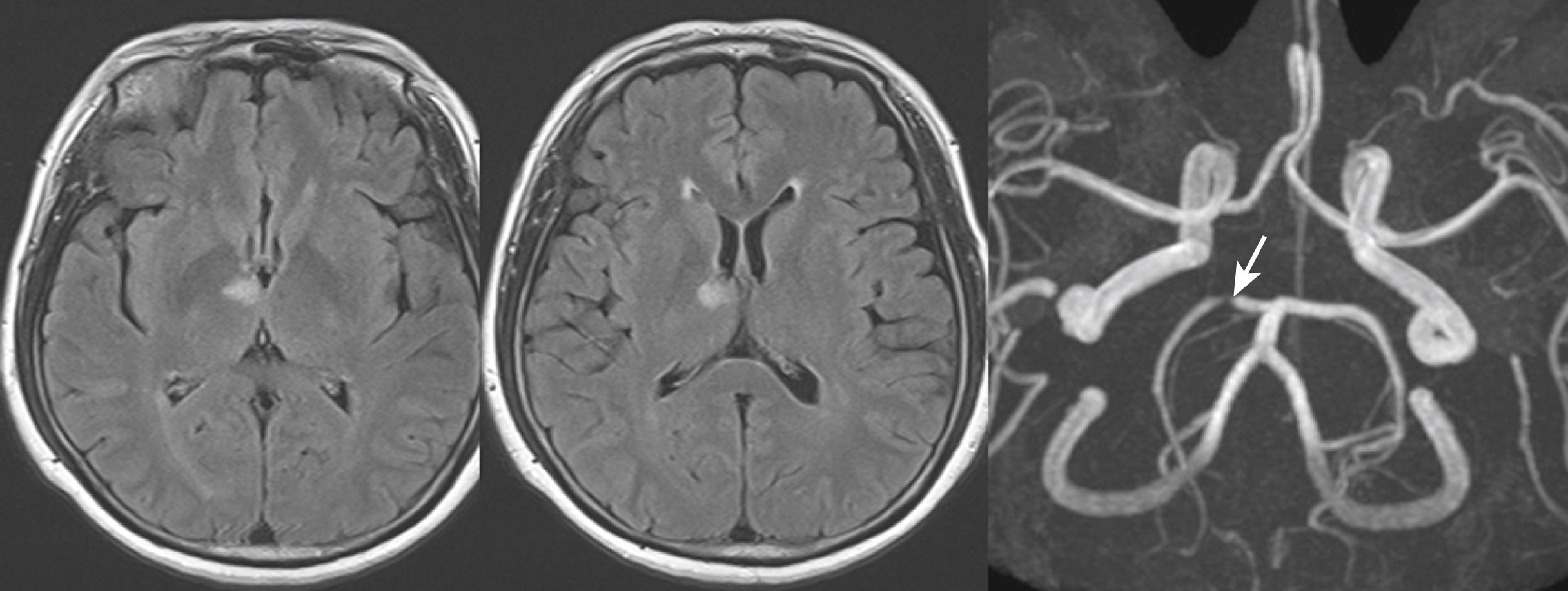
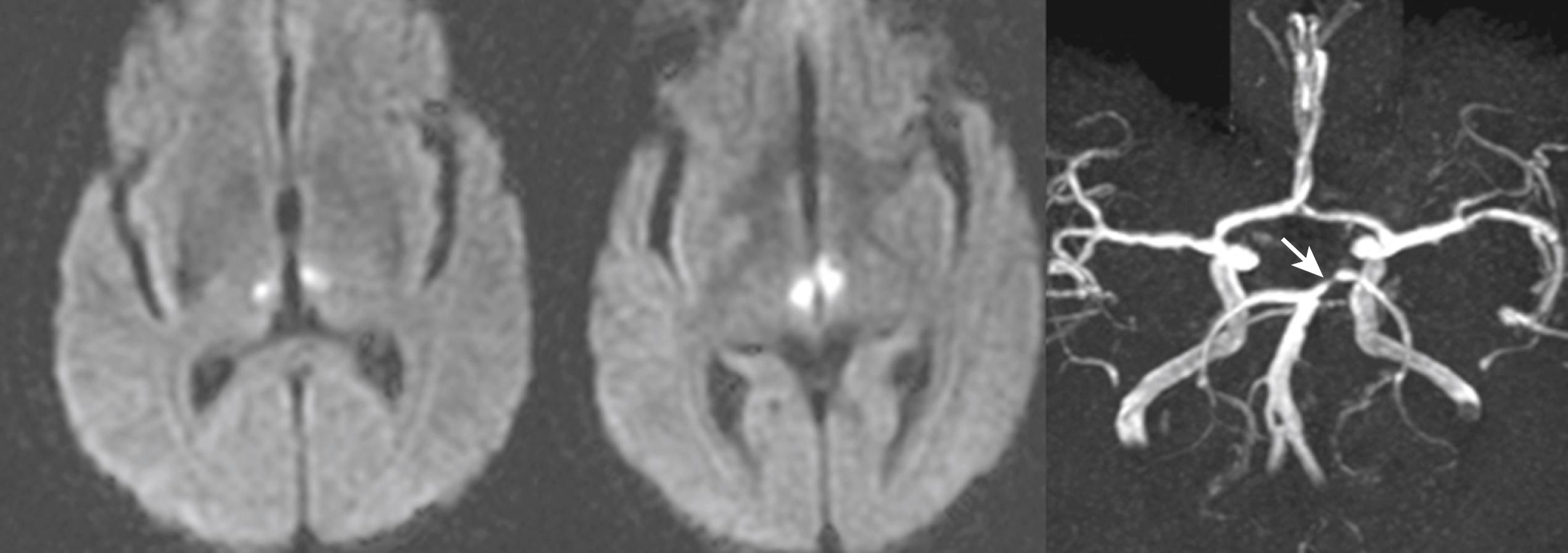
In patients with PCA atherosclerosis, thrombus formation in areas of plaque can result in total vascular occlusion, leading to infarction. , Occlusion of the proximal PCA may not produce significant infarction if the posterior communicating artery is well developed. On the other hand, P2 and P3 occlusions can produce relatively extensive infarction in the occipital lobe, medial temporal lobe, and thalamus. However, unlike cardiogenic embolism, in situ thrombotic occlusion less often produces sudden, large infarction because of the relatively well-developed collateral circulation in the setting of the chronic atherosclerotic process. However, the initial infarct frequently grows with persistent occlusion, leading to progressive neurologic worsening (see Figs. 25.4B and 25.9 ). Thus, the ultimate size of the infarct varies according to collateral circulation, the speed of arterial occlusion, and the hemodynamic stability of the patient.
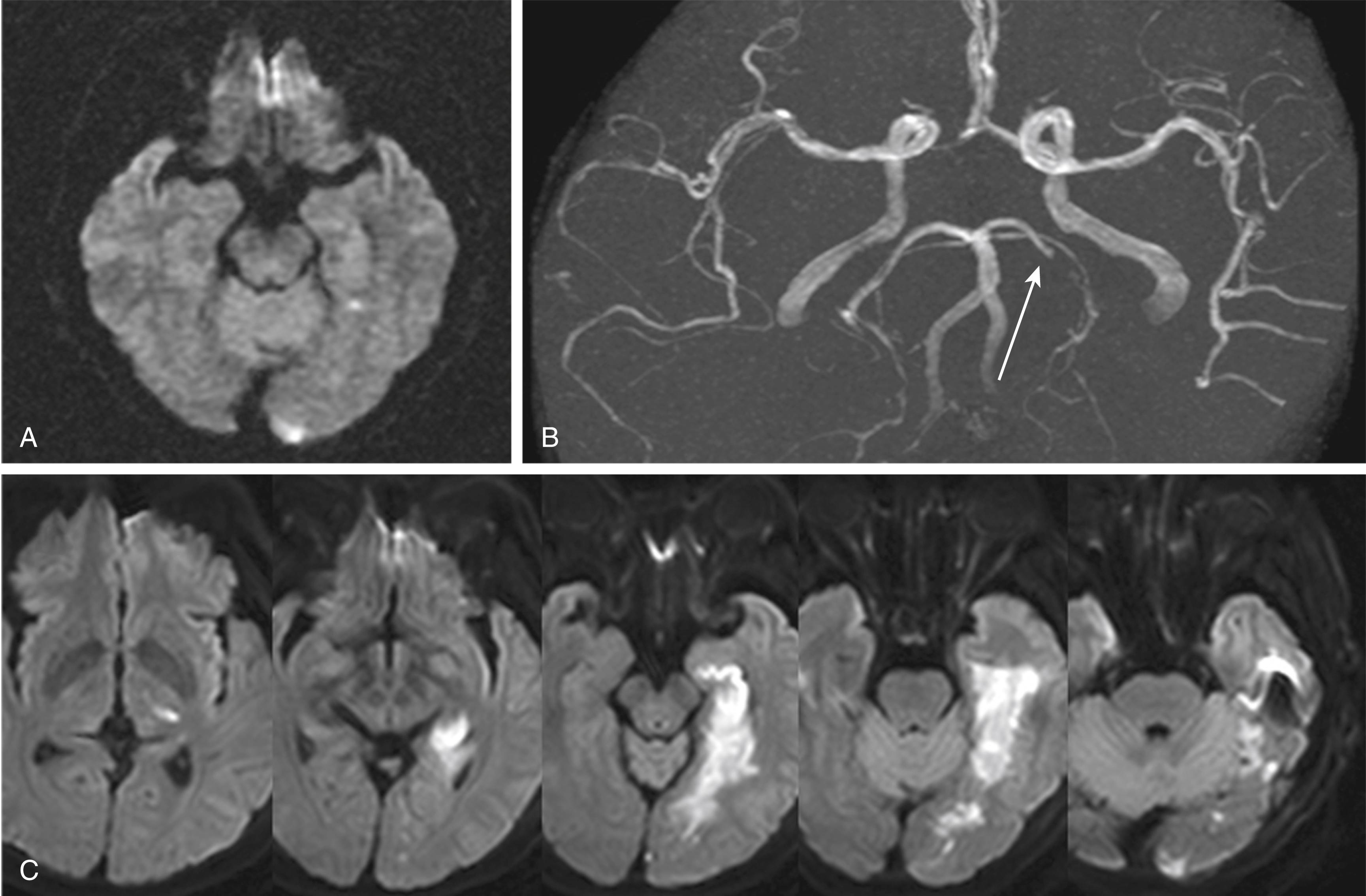
In patients with severe, bilateral VA, BA, or PCA steno-occlusive disease, hemodynamic mechanisms probably play a role in the development of ischemic lesions, especially when collateral circulation is insufficient (e.g., absent posterior communicating artery, inadequate compensation via leptomeningeal anastomoses form MCA or ACA). However, hemodynamic disturbance has not been discussed as a stroke mechanism in previous studies on PCA infarction. , , , ,
There are anecdotal reports that described hemodynamic failure as a stroke mechanism for bilateral infarcts that occurs in the borderzone area between the MCA and PCA territories, thereby resulting in Balint syndrome (see the section “Bilateral Infarction and Associated Syndromes”). , However, embolism in the borderzone area cannot be ruled out, and PCA infarction solely due to hemodynamic failure seems to be rare. More often, hypoperfusion plays an additive role—together with other major stroke mechanisms—that may eventually determine the extent of infarction. Hemodynamic insufficiency may be a mechanism of transient ischemic attack (TIA) that occurs in the PCA territory (see the section “Transient Ischemic Attack”).
Penetrating arteries in association with small subcortical or brainstem infarction demonstrate disorganized vessel walls, fibrinoid material deposition, and hemorrhagic extravasation through the arterial walls: this combination of findings was first called “segmental arterial disorganization” and then “lipohyalinosis” by Fisher. , These vascular changes develop in arteries or arterioles that are 40–400 μm in diameter and frequently affect the perforating arteries from the PCA that supply the thalamus and midbrain ( Fig. 25.10 ).
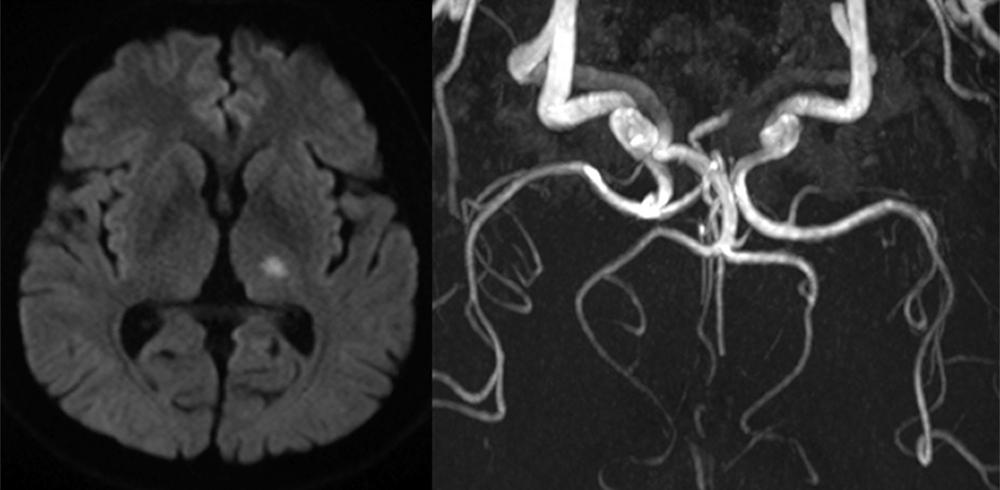
Although small-artery disease has been neglected as a potential cause of PCA territory infarction (see Table 25.1 ), recent series that included infarcts limited to the deep territory found that small-artery disease is the most or the second-most important cause of PCA territory infarction. ,
Cardiac embolism accounts for 18%–41% of PCA territory infarction. , , Atrial fibrillation is the most important etiology. The occluded artery is usually spontaneously recanalized, and the angiographic findings are often normal if angiography is not performed early. The hemorrhagic transformation of an infarct often occurs in association with recanalization and worsens patient’s headache and other neurologic symptoms ( Fig. 25.11 ). In one series, hemorrhagic infarction occurred in 44% of patients with PCA infarction due to cardioembolic stroke.
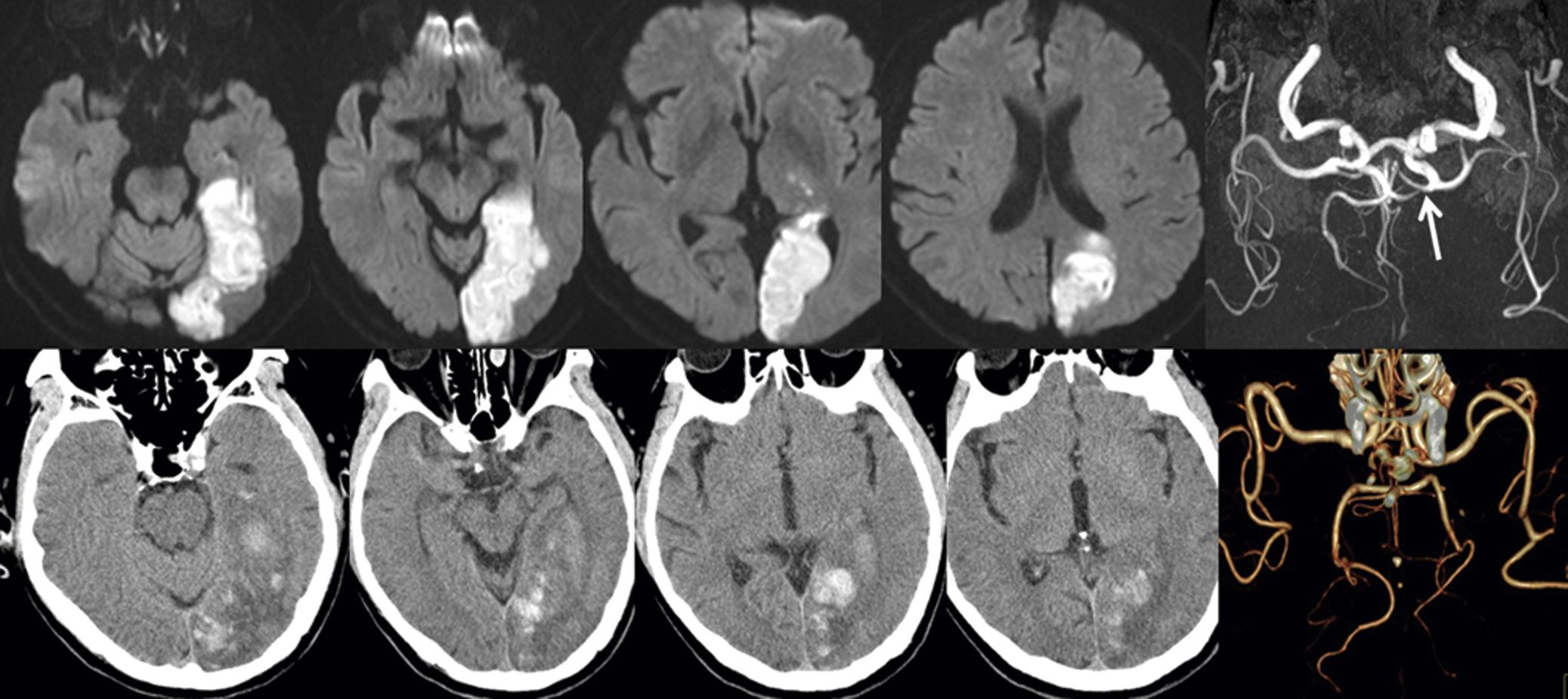
Patent foramen ovale (PFO) with a large amount of right-to-left shunting may be an etiology of embolic infarction (e.g., paradoxical embolism), especially in young patients without an evident cause of stroke. , As discussed in Chapter 26 , posterior circulation seems to be a predilection site for embolism in patients with PFO, , and PFO probably is an important cause of stroke in the previously described “cryptogenic embolism” group of patients. , , It seems that PFO should be suspected and investigated in young patients with PCA territory infarction due to unclear etiology. ,
In posterior circulation, dissection most commonly develops in the VA, either extracranially , or intracranially. Headache and neck pain can be the only complaints. Ischemic symptoms and signs may develop concomitantly or after a delay of hours or days. The lateral medulla and cerebellum are the most susceptible to ischemia due to VA dissection. , Although uncommon, VA dissection can be a possible donor site for distal embolism that leads to PCA infarction. , Dissection in the PCA is rare. In a review of 40 patients with PCA dissection, 15 had ischemia, 15 had subarachnoid hemorrhage, and 6 had aneurysmal mass effects ( Fig. 25.12 ).
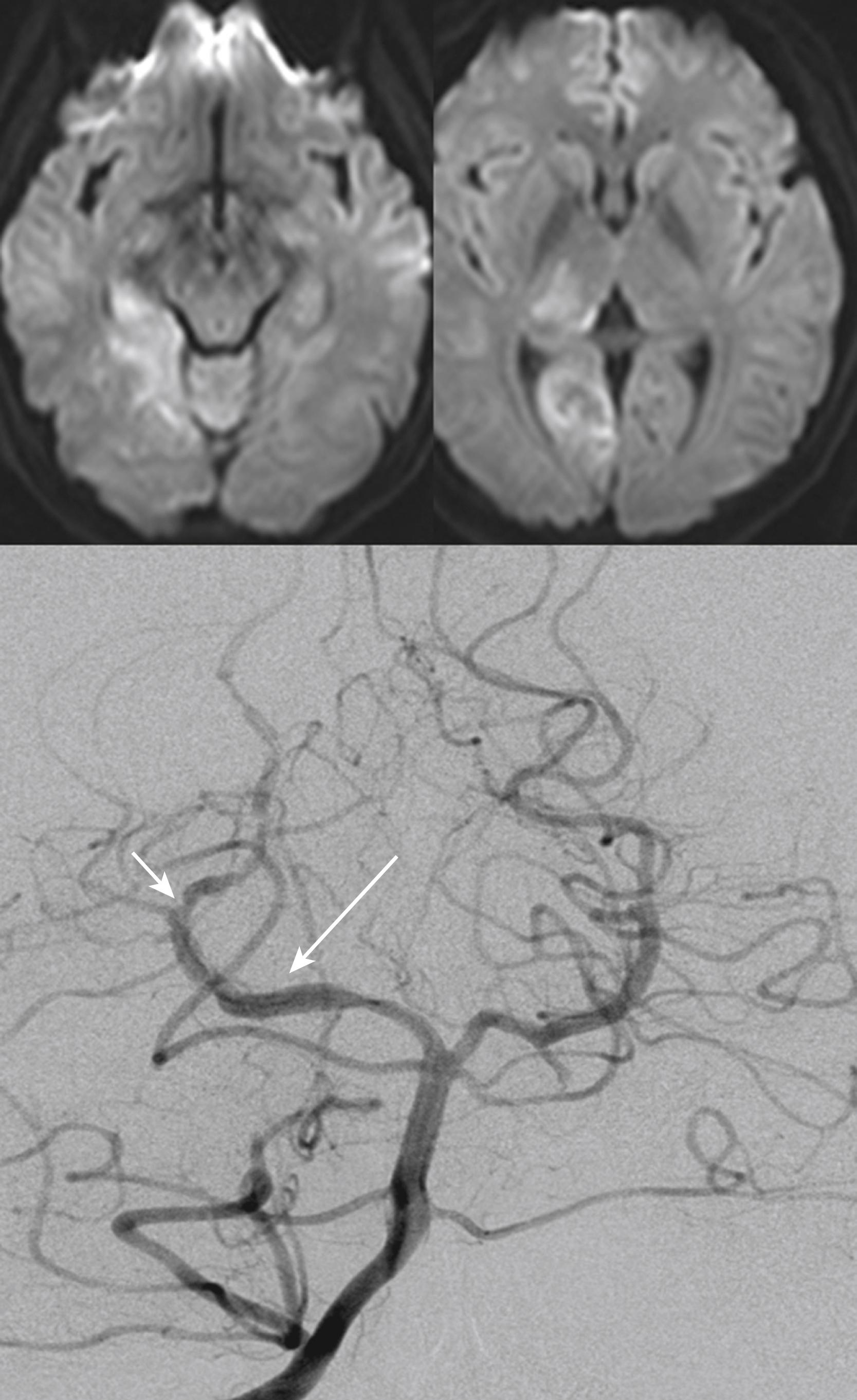
Migraine is considered closely related to posterior circulation ischemia, and previous studies described migraine as a cause of PCA infarction in 3%–14% of patients. , , However, it remains controversial whether migraine is the real cause of PCA infarction in these patients. Angiograms of patients with migrainous stroke occasionally show thrombotic arterial occlusion, and extensive investigations often reveal hidden embolic sources such as PFO with a large amount of shunting. , , , As discussed above, posterior circulation is a predilection site of embolism in patients with PFO. Therefore, the diagnosis of migraine stroke should be made very cautiously, and thorough etiologic examination should be performed even when PCA infarction develops in patients with migraine.
Moyamoya disease is characterized by the progressive occlusion of the distal ICA or proximal MCA and the development of fine meshworks of basal collateral vessels. Cerebral hypoperfusion is the predominant stroke mechanism in these patients, and repeated TIAs are observed when patients are dehydrated or hyperventilating. Less often, cerebral infarction due to embolism or thrombotic occlusion is encountered.
Posterior circulation stroke has been considered uncommon; it appears in the late stage of moyamoya disease associated with widespread vascular involvement including PCA. However, a recent study reported that PCA involvement is present in 29% of patients, with 17% demonstrating PCA territory infarction. There were no differences in the prevalence of PCA involvement and PCA territory infarction between pediatric and adult patients. These results suggest that PCA involvement may be more common in moyamoya disease than previously recognized, especially in young patients. Occipital infarction in moyamoya patients often includes a part of the posterior MCA territory, probably because vascular collaterals from the PCA supply a part of the MCA territory in these patients ( Fig. 25.13 ).
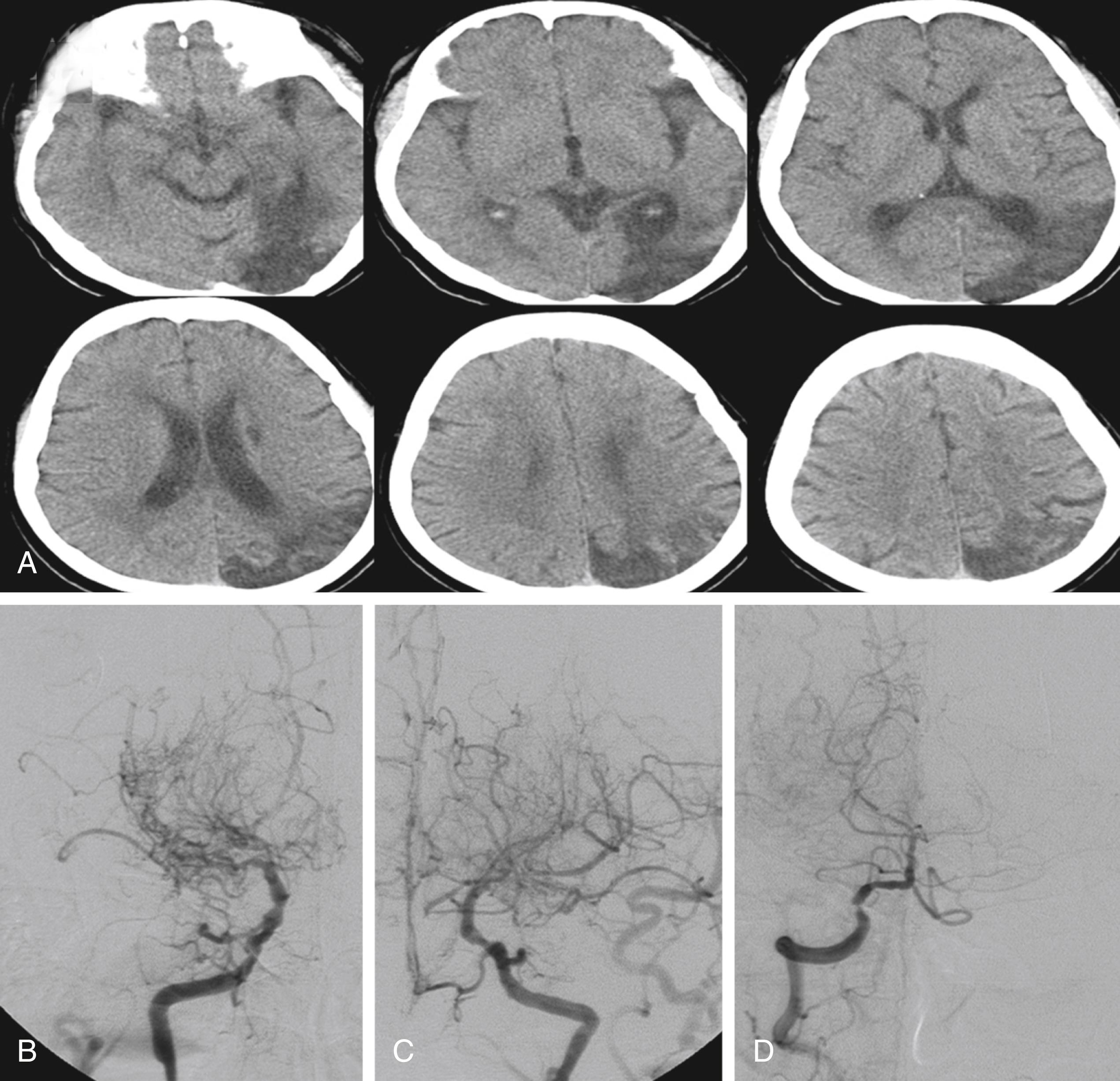
Fibromuscular dysplasia (FMD) is a vasculopathy of unknown cause that is characterized by hyperplasia of the intima and media of the arteries, adventitial sclerosis, and breakdown of the normal elastic tissue without inflammation. Thickened septa and ridges protrude into the lumen. The most common angiographic finding is the “string of beads” appearance: segments of constriction alternate with normal or dilated segments. The ICA is most often affected in patients with cervicocranial artery involvement (95%), and extracranial VA involvement has been reported in 12%–43% of affected patients. VA FMD may cause infarction via artery-to-artery embolism, hemodynamic insufficiency, or the combination of the two. Although rare, FMD may occur in the intracranial arteries such as BA or PCA resulting in posterior circulation TIA or infarctions. , FMD in the ICA may produce PCA infarction in patients with persistent fetal-type circulation.
Reversible cerebral vasoconstriction syndrome is characterized by severe headache with or without additional neurologic symptoms and the “string and beads” appearance in cerebral arteries; cerebral vasoconstriction generally resolves in 1–3 months. Cerebral infarction occurs in 4%–31% of patients, usually after hemorrhagic events (during the second week). Occipital infarction resulting in visual field defects is common in patients who develop stroke. Previously described conditions, such as postpartum cerebral angiopathy and migraine stroke with vasospasm, are now considered spectra of reversible cerebral vasoconstriction syndrome.
Arterial compression (or secondary thrombus formation) may produce PCA territory infarction. The most commonly observed example is PCA infarction that develops at the time of transtentorial brain herniation. The PCA is usually compressed in its course around the midbrain, medial to the herniated temporal lobe and lateral to the tentorium. , Compression may also occur on the side contralateral to the herniation because of the lateral displacement of the brainstem against the contralateral tentorium. Surgery or endovascular intervention on the posterior communicating artery or BA aneurysm may result in the occlusion of the PCA or its perforating branches.
Mitochondrial encephalomyopathy, lactic acidosis, and stroke-like episodes (MELAS) presents with infarction-like lesions, most frequently in the occipital area. , In a study of 38 young patients (≤45 years old) who presented with occipital infarction, 4 patients (10%) received a clinical or molecular diagnosis of mitochondrial disorder; 2 patients had A3243G mitochondrial DNA mutation. Therefore MELAS should be considered an etiology of young-age occipital infarction. The pathogenesis of stroke-like lesions seems to be associated with endothelial damage in the small arteries associated with mitochondrial dysfunction and metabolic derangement rather than large artery occlusion. Therefore, stroke-like lesions often do not exactly conform to the usual PCA territory ( Fig. 25.14 ). , Patients generally present with other features of MELAS, such as short stature, hearing impairments, seizures, and maternal family history.
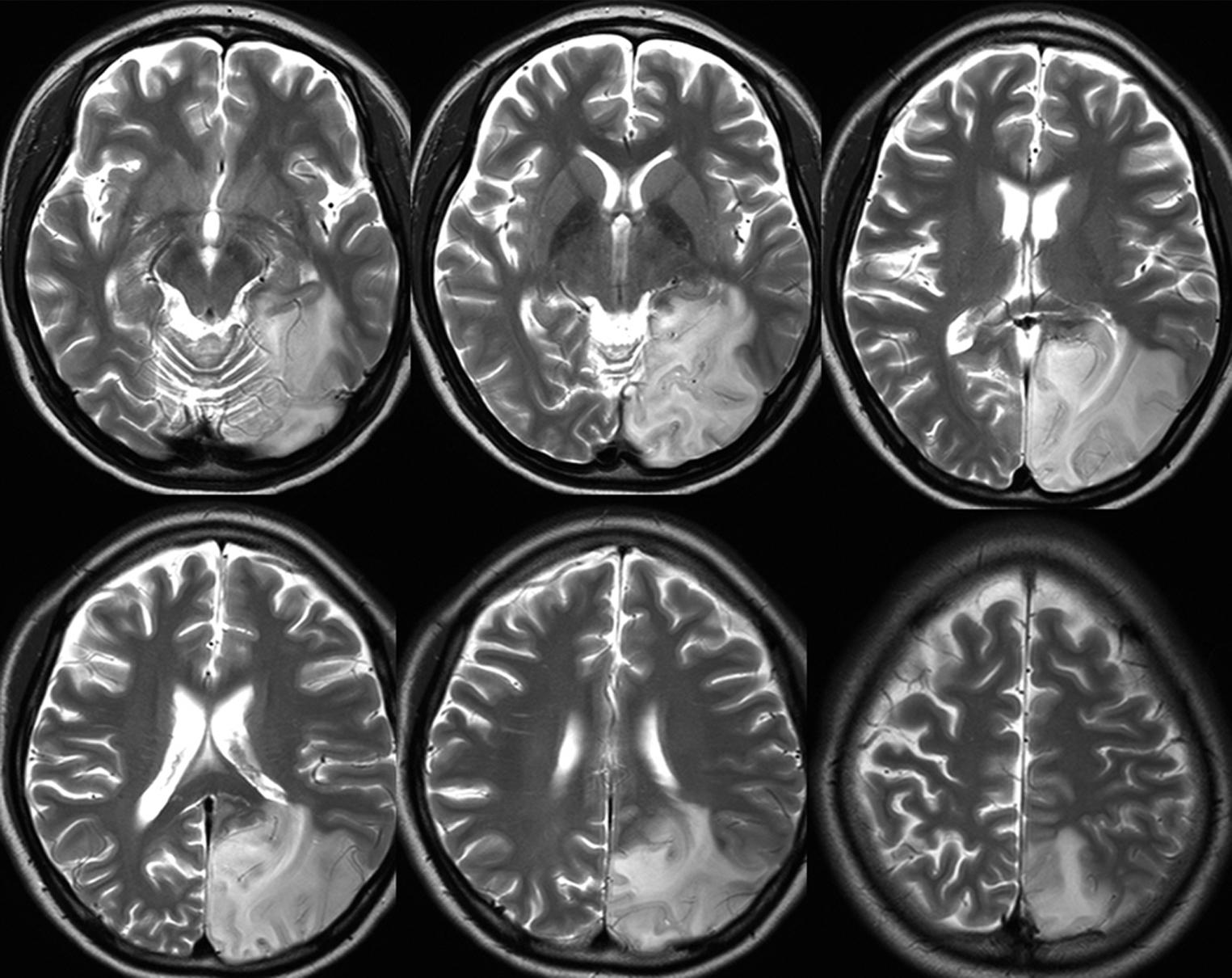
Become a Clinical Tree membership for Full access and enjoy Unlimited articles
If you are a member. Log in here